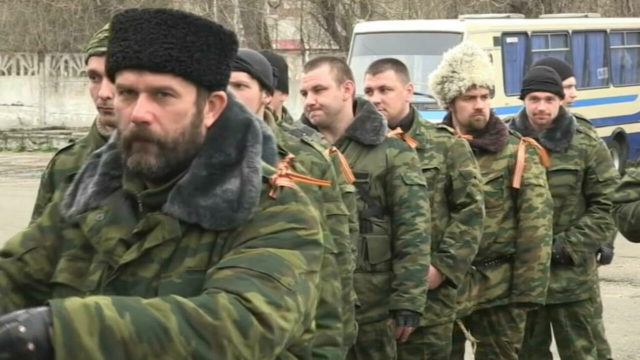
The Role of Cossacks in the Re-Invasion of Ukraine
Publication: Eurasia Daily Monitor Volume: 19 Issue: 28
By:

In Russia’s aggressive and unprovoked war against Ukraine, much of the global attention has understandably focused on the actions of the regular Armed Forces; but the Russian Cossacks are also playing a role in the conflict. On the opening day of the re-invasion, the head (ataman) of the All-Russian Cossack Society (Russian acronym VsKO), Nikolai Doluda, published an article reminding that “in 2014 the Kuban Cossacks were the first to come to the aid of the inhabitants of Crimea and held the onslaught of the Banderites [sic] on Chongar, Perekop, and Turkish Val; so today, the Cossacks of Russia do not stand idly by, but are aiding the residents of Donbas. After all, helping one’s neighbor and defending the Fatherland is the norm of a Cossack life.” The article also elaborates that “Russian Cossacks were among the first to respond to the call for help of the LPR and DPR [Luhansk and Donetsk ‘people’s republics’] residents. [And they carried out] systematic work to assist refugees. In seven Cossack voiskas [hosts or military societies] on the territory of ten regions, an operational staff works to assist in the accommodation of refugees evacuated from Donbas and in collecting humanitarian aid” (Vsko.ru, February 24).
The piece claims that refugees began arriving in Russia on February 18, and it cites the Ministry of Emergency Situations, which asserts that over 100,000 have already crossed into Russia. “Cossacks of the 12 registered Cossack voiskas as part of the VsKO continue to provide humanitarian help, necessities, medical supplies, warm clothes, protect public order at temporary accommodation points, complete volunteer work, and provide assistance to the border guards at checkpoints,” Doluda writes (Vsko.ru, February 24).
The article continues to explain that “in recent days, the Don [the region around Rostov], as the Russian region bordering the DPR and LPR, became the main ground for the placement of peaceful inhabitants. Cossack druzhini [squads] guard more than 100 points where there were more than 8,000 refugees. Two hundred twenty Cossack druzhini guarded social order around-the-clock. In addition, Cossacks are involved in receiving refugees at the Likhaya train station in the city of Kamensk-Shakhtinsky.” According to the VsKO ataman, the Central Cossack Voiska has created 45 refugee reception centers in the Moscow, Bryansk, Oryol, Voronezh, Belgorod, Kursk and Lipetsk regions. “Every day, about 260 Central Cossacks are involved in these territories to help refugees and protect law and order. The Cossacks also contribute to charity, with more than 700 donations to the needs of evacuees and already almost 12 tons of humanitarian help. […] The Cossacks of the Kuban voiska collected more than ten tons of produce for the inhabitants of the LPR and DPR. The Black Sea, Terek, Volga, and Orenburg Cossacks were included in the work” (Vsko.ru, February 24).
Two notable points emerge from this lengthy exposition of how the Cossacks are being used. First, the Cossacks are engaged in the elaborate reproduction of a crisis entirely manufactured by Moscow: those LPR and DPR “refugees” had fled (or been actively relocated by the authorities) due to Russian propaganda, not fact. Second, just as in Crimea, the state-led Cossack movement is being used to provide ancillary services such as aiding refugees and ensuring public order—probably to free up troops to be involved in the actual fighting.
Just the day before, Doluda had congratulated audiences on the Day of the Defenders of the Fatherland. Evoking the Russian imperial past, he claimed that “Patriotism, courage and service to the Fatherland have always been and remain the enduring values of the Cossacks. We are proud of our thousand-year history, perseverance and heroism of our ancestors… The Cossacks not only participated in the wars waged by the Russian state but also opposed the powerful Turkish Empire, along with the Kingdom of Poland and the Crimean Khanate” (Vsko.ru, February 23). The direct appeals to Russian history suggest an attempt to totally merge these heroic narratives with the notion of Cossackdom in the mind of the Russian public. Similarly, these specific historical appeals directly support claims that Putin’s model for the future Russian state is more the Russian Empire than the Soviet Union.
Likewise, the Cossacks were one of the key constituencies in Russia to immediately recognize the sovereignty and independence of the (Moscow-backed) breakaway regions of Ukraine—the LPR and DPR. Consistent with Putin’s narrative on the factors leading to the recognition of the statelets and the invasion of Ukraine, Doluda blamed “the use of Ukraine by the United States leadership as a tool for the implementation of its insidious plans, which is certainly very mean and low.” He continued, “How do you explain, [US President Joseph] Biden, the ‘innocent’ penetration of the diversionary-intelligence group BMP onto the territory of Rostov Oblast?” (Vsko.ru, February 22). Apparently, the BMP reference relates to five Ukrainian military operatives who allegedly crossed the border to help other saboteurs escape. Supposedly, they had been involved in shelling a farmhouse (161.ru, February 21). Of course, this was almost certainly a false-flag operation attempting to legitimate the recognition and subsequent re-invasion. It does, however, raise the possibility that Putin’s mendacity has become self-fulfilling, and Russia’s ruling establishment can no longer remember where the lies stop and start.



